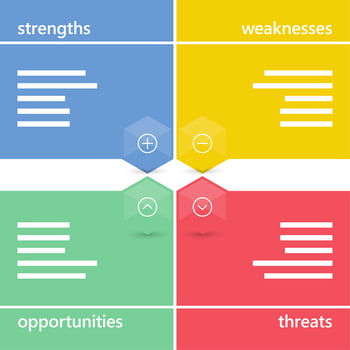If you want to make sure that you really occupy a unique spot in the market, you need to be aware of what your competitors are up to. A competitor analysis is the perfect way to profile the competition. It will help to build a wider picture of the marketplace and to establish where you fit within your competitive set. This can be done through online research, ‘mystery shopping’ (via the phone and at trade shows), requesting sales materials and even speaking to your customers and prospects for their opinions on your competitors.
Once you have carried out your research, SWOT (Strengths, Weaknesses, Opportunities and Threats) or Gap analyses can be used to establish your existing and desired position against your competitors. By pulling information about threats and opportunities into a single framework, you afford yourself an effective foundation upon which to build, implement or adjust your marketing strategy. Whether you’re looking to launch a new lab product or service, adjust your current pricing structure, or even enter a new geographical market, knowing more about your competition can only be a great asset. As such, this type of analysis is an important part of creating a overall marketing plan (as also highlighted in our recent free ebook on the subject).
Know your competition
In order to avoid competitive blind spots, you need to conduct your competitor analysis systematically. We’ve put together a series of simple and effective steps that will allow you to assess the competition and potentially gain an advantage:
1. Determine who your competitors are
Determine your top three to five competitors. You can expand this later if you need to, but for now, keep it short and focussed.
2. Create a framework
Set-up a document that outlines the parameters by which you will start to gain a picture of your competitors. This will help you to analyse their offering and services, along with how they position themselves. These are a few suggested fields to research:
- Company name and website address
- Geographical locations
- Mission statement
- Brand positioning (often as a positioning statement)
- Products/services offered (including applications/markets targeted)
- Key benefits they stress
- Pricing
- Perceived strengths
- Perceived weaknesses
3. Define your competitor research methodology
Decide the best way to generate the information you need to start to populate your competitor analysis framework document, e.g.:
- Web-based research
- Mystery shopping
- Interviewing customers and other 3rd parties
4. Allocate roles and responsibilities
When done properly, competitor analysis is a time-consuming but vital piece of on-going activity. Right from the outset, decide who will be responsible for each aspect of the competitor analysis, what they need to achieve, how you want them to report back to you and when the task needs to be completed by. Now you are ready to get started.
5. Don't forget to research the finances and news updates of your competitors
It can be helpful to have a feeling for your competitor’s profitability, methods of growth, or impending mergers and acquisitions. If they recently acquired a smaller biotech company for example, significantly expanding their own capabilities, you may need to readjust your own strategy.
6. Pull it all together to develop a SWOT or Gap analysis
Once you have completed the initial competitor research, you will be sufficiently well-armed to put together a SWOT or Gap analysis.

A SWOT analysis is a powerful tool that can be used in a number of different contexts, but in this case your SWOT analysis is a matrix for understanding how your competitors are positioned within the market, and importantly, where there are gaps. Competitor SWOT analysis places the competitor at the centre of your approach and will involve looking at the following:
- Strengths – For each competitor, list their main strengths and how these give them an advantage (i.e. these are their strengths).
- Weaknesses – Now begin to define where those competitors may be lacking or at a disadvantage (i.e. these are their weaknesses).
- Opportunities – Here you can use the information gathered to consider those aspects you could exploit to your own advantage (i.e. these are your opportunities).
- Threats – Understand those concerns that could cause trouble for you and your business. Get ahead of the game and start to think about how best to eliminate or counter these (i.e. these are the threats they pose to you).
7. Carry out on-going competitor monitoring
Of course, it is vital to constantly keep a keen eye on what the competition is up to, so this should be an on-going process. Some great tips for keeping up to date with the goings-on of your competition and to gain an understanding of their business and how they communicate with the market, include:
- Signing up to their newsletters
- Subscribing to and following their blog
- Following them on social media
- Setting up Google Alerts based around their company and brand keywords
Competitor analysis as part of your wider marketing plan
Performing a comprehensive competitive analysis is vital if you want your business to succeed. Not only will it determine the strengths and weaknesses of the competitors within your market, but it will also enable you to develop marketing strategies that will provide you with a distinct advantage and define any weaknesses that can be exploited as part of your marketing communications (and even future product/service development).
Competitor profiling, Gap and SWOT analyses are just parts of a much larger puzzle. To find out how to integrate them with other tools to develop a fully-formed marketing plan, download our free ebook: ‘Your 7 Stage Guide to Developing an Effective Life Science Marketing & Communications Plan’.




